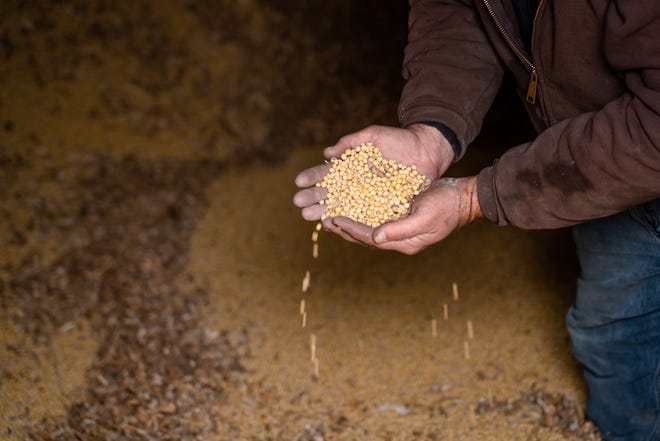How Much Bailout Money Did Trump Get During Recession
President Donald Trump's trade-related payments to American farmers have quietly become the mother of all bailouts.
Back when General Motors and Chrysler faced bankruptcy during the Swell Recession, Presidents George Due west. Bush and Barack Obama pumped billions into a rescue of the machine industry. That bailout ultimately toll the public about $12 billion when everything was settled and loans repaid.
But that looks similar pocket-size potatoes compared with the farm bailout underway at present. So far, Trump'south direct payments to farmers hurt by his merchandise dispute with Cathay have totaled some $28 billion — more than twice what the auto bailout price, co-ordinate to calculations from Bloomberg Businessweek. And the payments are nevertheless flowing with no end in sight to the merchandise dispute.

History of bailouts
The real mother of all bailouts came during the Great Recession when the U.S. authorities pumped virtually $200 billion into Fannie Mae and Freddie Mac, the regime-sponsored mortgage security agencies that were brimful with bad mortgage debt. But that money somewhen was repaid with profits for the authorities.
At that place is, in fact, a long history of government bailouts, mostly for failed banks. The news service Pro Publica lists 980 such bailouts, of which nearly generated a profit, or at least were repaid, in the end.
The government avant-garde some $60 billion to GM and Chrysler during the bankruptcies of which most was repaid except for the $12 billion that wasn't.
Why farmers are getting a bailout
Hither's the problem: China has purchased billions of dollars worth of American-grown soybeans, pork and other agronomics products over the years. Farmers' agronomical sales overseas have actually produced one of America'southward few trade surpluses. Just China's soybean and pork purchases, including those from Michigan farmers, have more or less dried upwards because of the trade dispute that saw each nation slapping tariffs on each other'south goods.
Farmers are pain. Net subcontract income this twelvemonth is expected to total well-nigh $58 billion, the second-lowest profit of the past ten years. That comes on tiptop of other recent troubles, including this year'south bound rains that delayed planting and a multiyear drib in the prices of agriculture commodities.
Trump is trying to ease that pain through straight payments to farmers injure by the trade state of war.
Yes, the government has been making directly payments to farmers for a long time. But the size of those payments is growing rapidly. From 2010 through 2017, straight government payments to farmers averaged about $11 billion a year. By the end of this yr, those payments are likely to hit nearly $twenty billion.
Or consider this: In 2013, directly government payments and federal crop insurance benefits made up twenty% of U.S. farmers' profits. This year, they'll total near 34% as revenues from actual sales drops.
More:Many Michigan farmers institute loopholes to squeeze more than greenbacks from Trump aid plan
More than:Michigan farmers boom Trump trade policies amidst new Chinese tariffs
With no stop in sight to the trade dispute with Prc, despite occasional hints of progress in the on-again-off-again negotiations, the payments to farmers hurt by lost sales await likely to grow next year.
Imminent failure vs. market place ups and downs
Here'due south another divergence with the auto manufacture rescue of a decade ago: The auto industry's giants, GM and Chrysler, were truly facing imminent failure during the Great Recession. Fears that a collapse of GM might cost 3 million jobs in the U.Southward. economic system through ripple effects spurred the rescue effort.
Despite the dire need of the auto industry, that endeavour was controversial. Some conservatives argued that defalcation might be a better solution.
By contrast, American farmers, while facing some normal market ups and downs in recent years, were in nowhere almost the same perilous position before the trade dispute disrupted their sales.
Indeed, the plummet of U.S. soybean sales to China was a cocky-inflicted wound bought on past trade hawks in Trump'southward inner circle and their impuissant handling of legitimate trade disputes.
And now, having punished U.Due south. farmers to make his signal with China, Trump showers them with cash to keep them happy enough so he doesn't lose their political support.
In what state does that brand sound economic sense?
Contact John Gallagher: 313-222-5173 or gallagher@freepress.com . Follow him on Twitter @jgallagherfreep . Read more on business and sign upward for our business newsletter.
Source: https://www.freep.com/story/money/business/john-gallagher/2019/09/24/farmer-bailout-payments-china-trade-tariffs/2418676001/
Posted by: pelletiermoseeld.blogspot.com

0 Response to "How Much Bailout Money Did Trump Get During Recession"
Post a Comment